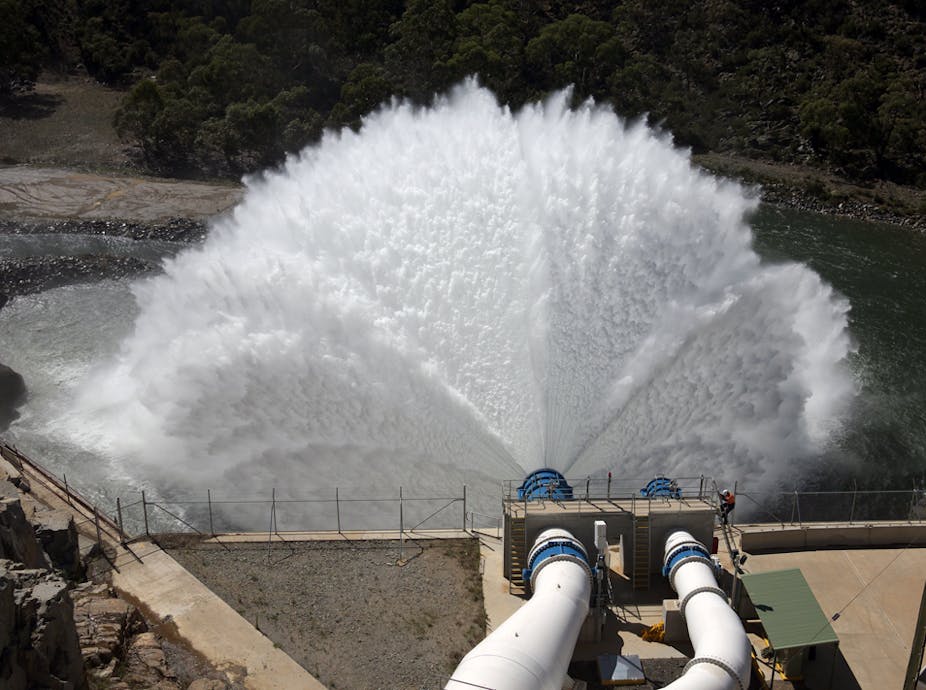Water exploding from the Jindabyne Dam into the Snowy River made for compelling viewing in recent TV news reports.
As well as being good TV, this water release highlighted the importance of releases in maintaining ecological integrity downstream of dams.
Around the world, wild rivers with no barriers (or dams) are becoming increasingly rare. This is particularly the case in Australia – a dry continent with multiple, conflicting demands for water.
These demands – for drinking water, power generation, and irrigation – have resulted in the construction of numerous dams and weirs. More often than not this has been at the expense of the natural environment.
Once a river is dammed it changes its physical and chemical structure. Damming also changes the biological communities associated with the river and its floodplain.

When water is kept behind dams, seasonal flow patterns are usually lost. Drying up in the summer can occur to a lesser or greater degree, but the big problem is there’s no rush of water when the rains begin. High flows in summer (floods) are much fewer in number, shorter and less powerful.
Floods and high flow events are critical in maintaining healthy rivers. High flow removes sediment from pools, riffles and runs.
Pools give organisms a refuge from summer heat and predators but when they fill with sediment – due to limited clearing flows – they no longer provide this function.
Sediment in riffles and runs means the small spaces between rocks are lost, significantly reducing the space available for a variety of bugs, fish and yabbies (crayfish).
Periods of high flow drown out natural barriers such as small cascades, or long shallow areas. Under low-flow conditions these barriers prevent the movement of some fish species, including eels and Murray Cod. Such species need to move substantial distances, or even the length of a river and to the sea, to complete their life cycle.
High flows connect isolated wetlands to rivers, helping to maintain floodplain wetlands. High flows are also important in maintaining the shape and form of river channels.
A lack of flooding means the river channel contracts and riverside vegetation invades the stream channel, reducing habitat for fish and other aquatic organisms.

Of course, rivers don’t flow at the same rate all the time – flow variability is important. Australian rivers have the most variable flow regimes in the world, so going from very low to high flows is not uncommon.
Our native aquatic organisms (known collectively as “biota”) are well adapted to this variability, but alien fauna may be less well adapted. In this way, returning a waterway’s natural flow variability is likely to benefit native species.
When a dam is opened, the amount of water flowing out of it seems huge. Flows similar to those being released from Jindabyne and Tantangara dams would have been normal before damming and our native fauna is well adapted to these conditions.
Moreover, high flows and flood events may provide environmental cues, stimulating a range of biological processes, including:
- breeding and migration in native fish
- dispersal of bug larvae, and
- (possibly) frog breeding.
We cannot return all the flows needed to our rivers and return the ecosystems to pre-development condition, because of other water demands (such as drinking water, irrigation and power generation). We therefore have to target water delivery to specific objectives. In other words, we need to get the best bang for our watery buck.

The ongoing and proposed releases have been designed for specific purposes, based on imperfect knowledge but sound scientific principles.
The response in rivers is unlikely to be immediate – a river deprived of water for 50-60 years will not recover from one flow event.
That said, as long as the water released is the right quality (that is, not cold, deoxygenated water released from the bottom of dams), released at the right time of year and is designed to mimic that of a natural event, then a trajectory toward recovery can be expected.
The flows being released from the Tantangara Dam are being assessed by scientists at the University of Canberra’s Institute for Applied Ecology (where the three of us work) to determine the response of downstream ecosystems. This information will then be used to guide the timing and extent of releases.
Only with such information can we confidently determine appropriate and achievable objectives for our rivers.

